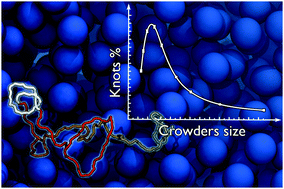Tuning knot abundance in semiflexible chains with crowders of different sizes: a Monte Carlo study of DNA chains†
Abstract
We use stochastic simulation techniques to sample the conformational space of linear semiflexible polymers in a crowded medium and study how the knotting properties depend on the crowder size and concentration. The abundance of physical knots in the chains, which for definiteness we model on 10 kb long DNA filaments, is shown to have a non-monotonic, unimodal dependence on the colloid diameter, dc. The maximum incidence of knots occurs when dc is about equal to half of the gyration radius of the isolated chain. The degree of enhancement of knots grows rapidly with the solution density and can be very conspicuous relative to the case of isolated chains with no crowders. For instance, at 30% volume fraction the relative increase is more than fourfold. This dramatic enhancement is shown to originate from the depletion-induced chain compaction over multiple and concurring length scales. The same effect accounts for the variations of the knot length that accompany the changes in knotting probability. The findings suggest that crowded media could be viably used as a passive physical means for controlling and modulating the incidence and length of knots in DNA and other types of semiflexible polymers.


 Please wait while we load your content...
Please wait while we load your content...